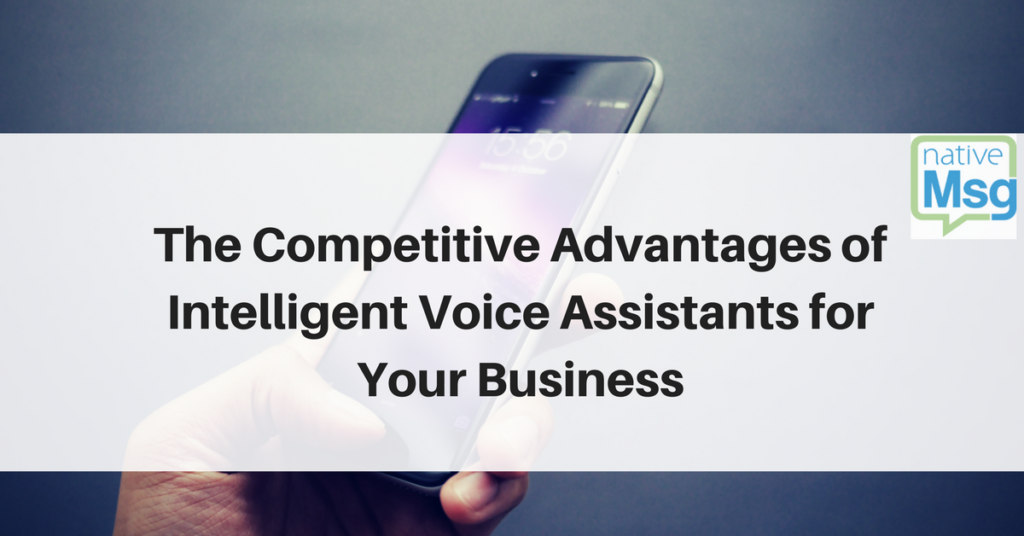
“Hi Voice Assistant. Can you,
answer this simple question…”
answer this complex question quickly…”
schedule…”
tell me how..”
call…”
cancel…”
analyze this data…
diagnose…”
The answer now is Yes. On all the above. Yes.
It’s obvious intelligent voice assistants (voicebots) and chatbots are here to stay. If big tech hasn’t made the case, then customer experience should. The ease, always-open nature and consumer convenience is the answer to omnichannel marketing.
But how does your business start?
Current State of Voice Assistants and Voicebots
- Third party developers can use the tech from Siri and Alexa, for example, to create and customize voice assistants for your business.
- Native applications are also a solution to give your organization increased control and oversight.
- By 2020, 50 percent of search will be voice search. The future has a way of coming around the corner, softly, it’s here. It’s here to help you.(source)
- Per one major study, voice recognition platforms can be three times faster and accurate than typed text. (source)
- 20% of Google search is carried out by voice. (source)
- In 2018, most consumers––62%––are totally cool with it. (source)
- By 2020, 20% of businesses will adopt voice assistants and voice assisted search.
- Generally, Millennials are leading the way in usage and adoption.
Voice assistants and the future of conversational AI are effortlessly moving from the home ecosystem of IoT and sliding into onsite, B2C and B2B experience.
What does that mean for your business?
How can you use it with existing channels and what’s the overarching benefit of integrating intelligent voicebots (as well as chatbots) onsite and within your customer service and logistics experience?
Here’s a look at the benefits of intelligent voice assistants and what your business needs to know to prepare for it.
B2B and B2C Benefits
Sure, everyone loves cool technology, but cool tech should simplify, facilitate, support and engage. That’s what makes voicebots so compelling now. Voice assistants can easily check all these boxes for business.
Consumers have grabbed hold of Alexa and Google Home confidently adopting the tech into their lives. The 2017 holiday season was the season of Alexa, with “tens of millions of sales,” per Amazon.
Smart Homes are the springboard. We are firmly planted in the age of IoT with convenient voice assistant tech. From your television to refrigerators, thermostats and auto, you can connect almost anything. (Yes, you can even connect your dog and dog collar.)

Consumers are Ready for Onsite Voice Assistants
Consumers, primed by the home market, are ready for business tools and experience and organizations have started to understand this:
Historically and largely within the home market, consumers have used their smart home devices for search and one-step commands, as in, please turn-up the volume or search for a recipe.
Intelligent voicebots are fast moving beyond simple-step commands. Yet, here we are, still typing and texting away to customers and asking them to tap back in cases where it isn’t necessary or convenient.
Subscribe to our Newsletter
Voice-First Edge
Queries and simple commands are still fantastic functionality. But combined with better deep learning and NLP, the opportunities for cross-functionality create a great shift in a consumer’s digital experience. Your intelligent conversational UI, can be “trained” to respond wherever your customers engage.
The end-user experience isn’t the only big benefit. It’s a foundational shift for how you communicate with your customers.
- The architecture enables ubiquity in communication.
- It’s not a one-size fits all governance, either. Communication can be personalized for each user experience––on every channel.
- The always-open nature of intelligent voice assistants and chatbots is so refreshingly helpful for customers who are accustomed to wait times and poor response.
- Finally, the technology cuts down on social bias and supports tech democratization and better access to service where typing isn’t integral or even welcome (on-floor retail, mechanics, driving and even during medical procedures or consultations).
“One-Brain” Architecture Enhances Apps, Revolutionizes Online Experience
Sure, you might be wondering if this is a fantastical generalization given current limitations you may have experienced, with, say, Siri. “Hey Siri, do you like long requests or short ones?” Siri: “This is about you, not me?”––sound familiar?
No one’s knocking how effective Siri’s been in many “get/command” scenarios and in leading the way in voice assistant capabilities. However, deep learning, the way machines learn from repeated experience, based on big data and algorithms, can enable more sophisticated functionality.
- Voice assistant technology is not a stand-alone solution, with constant iterations of updates and downloads as apps have historically been. It’s a cloud-based solution that provides multi-channel engagement and a perfectly evolving platform for future channels.
- Cloud-based solutions are just the start. Self driving cars need an even more immediate solution if a server is down. Instead, connected smart cars and architecture, via AI APIs will be the new infrastructure that “talk,” so that the whole of your voice assistant architecture can “live” on an IoT connected platform.
- Voice assisted chatbots on-site are the way conversational UI can evolve to where your customers engage. Native voicebots, apart from social channels, stand to increase your control of data and customer experience. Your customers can reach your voice assistant onsite, on social, on email and on device where they can continue the conversation easily.
Ease in Voicebot Product Launch
Laying this foundation now will create a competitive advantage for product development teams.
- Integrating a voicebot solution onsite can decrease the come to market timeline. It is feasible for an enterprise business to create a prototype design within a few weeks and a launch soon after while also continuing to train data when its live.
- Moreover, with machine learning, intelligent voicebots can grow with experience so data training, rather than lengthy testing, is an expected part of the process after launch.
- Cutting down on product development timing creates operational cost savings.
Use Cases Now
Utility Giant Exelon Assists Customers with Savings, Answers
Chicago-based Exelon deployed a voice assistant bot to help customers with billing information, energy-cost saving ideas and outages.
The utility company has experienced a shorter product launch time. It has connected the product to its IT databases to harness customer data and provide better responses. They don’t have to recreate the wheel by writing and coding for a number of different channels. Instead the architecture and API allows them to deploy to several platforms and devices to reach customers, quickly, on preferred messaging channels
Retail Rallies Consumer in Voice Assisted Shopping
Large retailers, like Target and Costco are also hopping into the mix to allow consumers to shop by voice. But more importantly, consumers can also do so on smartphones. Busy professionals, parents or your home-bound great-aunt can access grocery delivery all by voice commands.
But the unique aspect is that most businesses have just begun to consider how and where to use voice assistants for their brand and engagement.
How to Prepare

Every leading tech company is racing to the forefront with advancements, largely for home and B2C. The countdown has begun on Apple’s Homepod release this week and Amazon’s set to unveil a new voice approach on Super Bowl Sunday.
Voice has come far in the last decade. Accent comprehension, exemplary speech recognition and full-throttle, low-cost consumer access is the norm today.
But the combination of a voice assisted, voice-first conversational site is perhaps the most dynamic way for your business to offer responsiveness.
The idea is that your customer can interact in every way and in every place they engage online. Your business can integrate a voicebot or chatbot API into your current IT system or start with a social channel where your consumers most align.
However, the strength of visuals can’t be underestimated when it comes to intelligent voicebots.
Organizations need to address that voice search is going to be part of SEO optimization and marketers need to be savvy about how this technology is transforming your customer experience.
Given that I opted to type the last few sentences of this piece by voice, it’s a natural corollary, voice tech is a commodity awaiting B2B mining.
Want to learn more about how a conversational site or component can create huge engagement, easier lead-building and better brand experience? Get in touch with nativeMsg for a consultation.
Free Trial
Get Started With RCS
Business Messaging!
Unlock the power of RCS and revolutionize your customer engagement.


